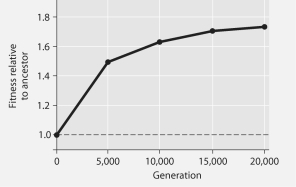The following questions refer to Figure 27.1 below, which is the same as Figure 27.10 in the textbook.
In this 8-year experiment, 12 populations of E. coli, each begun from a single cell, were grown in low-glucose conditions for 20,000 generations. Each culture was introduced to fresh growth medium every 24 hours. Occasionally, samples were removed from the populations, and their fitness in low-glucose conditions was tested against that of members sampled from the ancestral (common ancestor) E. coli population.

Figure 27.1
-Which of these can be inferred from Figure 27.1?
A) Most of the genetic change that permitted adaptation to the new, low-glucose environment occurred toward the conclusion of the experiment.
B) Rates of mitosis increased over the course of the experiment.
C) The highest rate of genetic change occurred during the first quarter of the experiment.
D) After 5,000 generations, the bacteria were 100% more fit than the original, ancestral bacteria.
Correct Answer:
Verified
Q27: The following questions refer to Figure 27.1
Q28: The following questions refer to Figure 27.1
Q30: Regarding prokaryotic reproduction, which statement is correct?
A)Prokaryotes
Q31: The following questions refer to structures found
Q33: The following questions refer to Figure 27.1
Q34: Figure 27.2 depicts changes to the amount
Q35: Match the numbered terms to the descriptions
Q36: The following questions refer to Figure 27.1
Q37: Figure 27.2 depicts changes to the amount
Q60: The following questions refer to Figure 27.1.
In
Unlock this Answer For Free Now!
View this answer and more for free by performing one of the following actions

Scan the QR code to install the App and get 2 free unlocks

Unlock quizzes for free by uploading documents